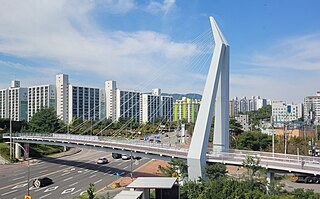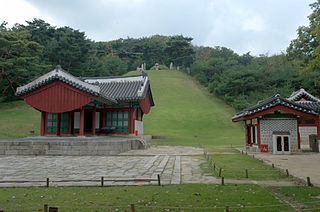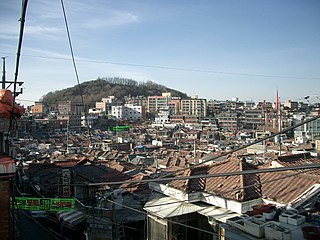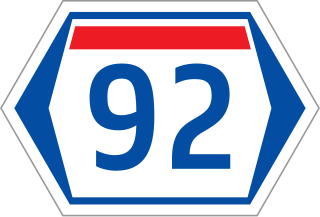
Suncheon (Suncheon-si) is the largest city in Jeollanam-do, South Korea, with a population of 280,719 as of 2022. It is located in the southeast of the province and is a scenic agricultural and industrial city, known for tourist attractions, such as Suncheon Bay. The port city of Yeosu is around forty minutes south of Suncheon and Gwangyang twenty minutes to the east of the city.

Cheonan is the largest and most densely populated city of Chungcheongnam-do, South Korea, and the third largest city in the Hoseo region after Daejeon and Cheongju. Cheonan borders Gyeonggi-do in the north, Chungcheongbuk-do to the east and southeast, Sejong City to the south and Asan-si and Gongju-si to the west and southwest.

Bongcheon Station is a station on the Seoul Subway Line 2. It is located in Bongcheon-dong, Gwanak-gu, Seoul, South Korea, close to Gwanaksan Mountain.

Nakseongdae Station is a station on Seoul Subway Line 2. This station is named after a nearby place called Nakseongdae, which was the birthplace of the great Goryeo general Kang Kam-ch'an, best known for his heroics against an invading Khitan force in the Battle of Gwiju.

Sillim Station is a station on Seoul Subway Line 2 and the Sillim Line. It is located in Sillim-dong, Gwanak-gu, Seoul.

Yeongdeungpo District is an administrative district in southwest Seoul, South Korea. Although the origin of the name is uncertain, the first two syllables are thought to be from "yeongdeung" (靈登) or "divine ascent", a shamanic rite. The third syllable is "po", representing the bank of a river (浦), referring to the district's position on the Han River. The 2006 population was 408,819.

Seoul National University Station is a station on Seoul Subway Line 2, located in Bongcheon-dong, Gwanak-gu of southern Seoul. This station is also known as Gwanak-gu Office Station. There are eight exits, two at each corner of the crossroads – of Nambu Beltway (Nambusunhwan-ro) and Gwanak-ro – where the station lies beneath.

Seocho District is one of the 25 local government districts which make up the city of Seoul, South Korea. Seocho is a part of the Gangnam region, along with the Gangnam district of Seoul. Seocho District ranks as one of the richest neighborhoods in South Korea and among the most expensive areas in Seoul with an average sales price of 47.75 million South Korean won per 3.3 square meters. Many of the wealthiest residents are concentrated in the three Gangnam districts including Seocho, known as Gangnam School District Eight.

Seongbuk District is one of the 25 districts of Seoul, South Korea. The district is located in the mid-north part of the city. The current Mayor is Kim Young-bae (김영배), who has been mayor since July 1, 2010. Seongbuk-gu was established under Presidential Decree No. 159 on August 13, 1949, and was promoted to a autonomous district by implementing a Gu-level local government on May 1, 1988.

Dongjak District (Dongjak-gu) is one of the 25 gu that make up the city of Seoul, South Korea. Its name was derived from the Dongjaegi Naruteo Ferry, on the Han River which borders the district to the north. It was the 17th gu created in Seoul, after being separated from Gwanak District on 1 April 1980.

Gangseo District (Gangseo-gu) is one of the 25 wards (gu) of Seoul, South Korea. It is located on the south side of the Han River. Gimpo Airport is in Gonghang-dong, where many flights fly to cities like Busan, Jeju, and Gwangju.

Geumcheon District (Geumcheon-gu) is one of the 25 gu (districts) of Seoul, South Korea. It was created from southern parts of Guro-gu and tiny sections from Gwangmyeong in 1995. Its district office is located in front of Siheung Station, now Geumcheon-gu Office Station, in Siheung-dong.

Seocho-dong is a dong, or neighborhood of the greater Gangnam area Seocho-gu district of the South Korean city of Seoul. Seocho-dong is divided into 4 different dong which are Seocho 1-dong, 2-dong, 3-dong and 4-dong. The main street is Teheranno. There is Gangnam Station in Seocho-dong, which is one of the biggest stations in Korea.

Bongcheon or Bongcheon-dong is a statutory division of Gwanak District, Seoul, South Korea. Its name means "enshrining heaven" which was derived from its location, northern skirt of Mt. Gwanak, stretching to the mountain ridge. It consists 9 administrative neighbourhoods. District office of Gwanak is located in Bongcheon.

Sillim-dong (Korean: 신림동) is a dong (neighborhood) of Gwanak District, Seoul, South Korea. Seoul National University and Nokdu Street are located in the town. Its name means "new forest", which was derived from the woods outstretched from Mt. Gwanak. It consists 11 administrative neighbourhoods.
Siheung County, alternatively Shihŭng County was a county (gun) in Gyeonggi Province, South Korea. This county was abolished in 1989 as its one town(읍) of Sorae and two townships(면) of Gunja and Suam became Siheung City at the same time. Today's Siheung City area did not belong to Siheung County before 1914. The area rather was part of old Incheon or Ansan.

Seoul Metropolitan City Route 92 is an urban road located in Gyeonggi Province and Seoul, South Korea. With a total length of 44.6 km (27.7 mi), this road starts from the Haengju Bridge in Gangseo District, Seoul to Amsa Water Purification Facilities in Gangdong District. Nambu Beltway is a part of this route.

Nambu Beltway (Korean: 남부순환로) is a 6-10 lanes urban road located in Gyeonggi Province and Seoul, South Korea. With a total length of 32.6 km (20.3 mi), this road starts from the Gimpo International Airport Entrance Intersection in Gangseo District, Seoul to Suseo Interchange in Gangnam District. Nambu Beltway is a part of Seoul City Route 92.

Gwanaksan Station (Korean: 관악산역) is a subway station on the Sillim Line in Gwanak-gu, Seoul. It will be a transfer station with the Seoul Light Rail West Line in the future. From this station to Saetgang Station, all stations are underground. There are two late-night trains that stay at the station overnight.

Danggok Station (Korean: 당곡역) is a station on the Sillim Line. It is located in Bongcheon-dong, Gwanak-gu, Seoul.























